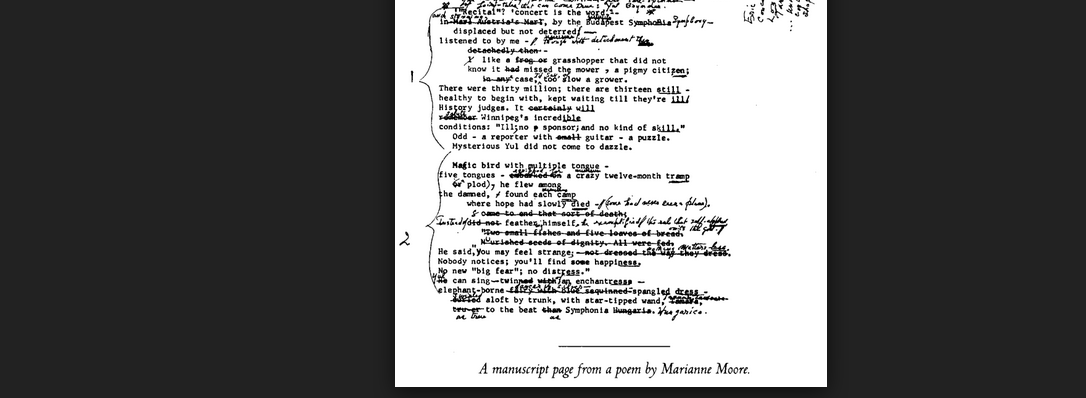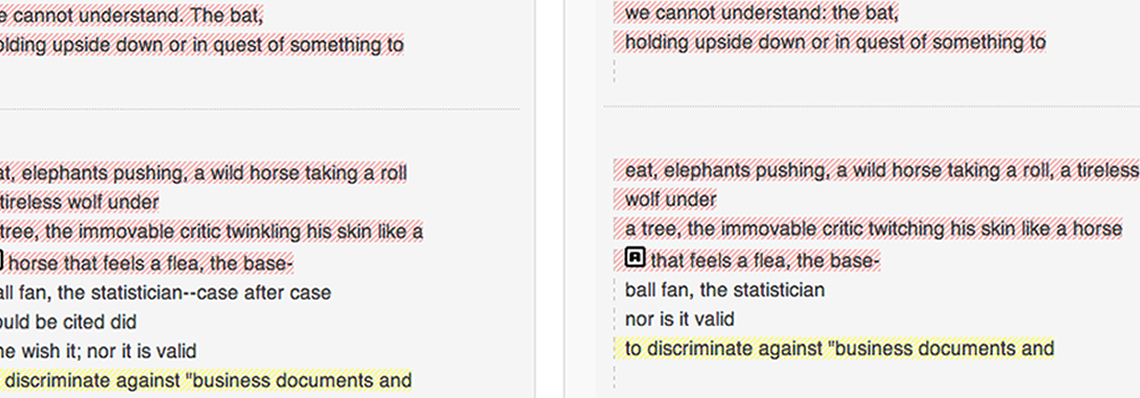Last week Alex, Katie, Jentery and I posed the question: Why modernism for versioning? And so to approach this sweeping inquiry we’ve selected small portions of modernist text to version as case studies. This, of course, led me to consider what we could glean from tracking the differences in the multiple versions of Moore’s much-revised “Poetry.”
What is the half-life of modernism in Marianne Moore’s “Poetry”? Through versioning I aim to trace Moore’s shifting modernist techniques by way of the 1919, 1924, and 1967 incarnations of the text. These versions articulate different visions of Moore over time. Perhaps, even, there’s an account of modernism embedded in the mutating poem, as it stretches from the early to mid twentieth century. Maybe it’s simply the story of Moore’s relationship with modernist poetics.
Moore edited her poetry incessantly and with severity. And yet the earlier versions of poems she disavows established Moore as a high modernist poet alongside the likes of William Carlos Williams, H.D., Ezra Pound, and T.S. Eliot. While studying earlier versions of Moore’s poetry casts light on the younger poet of the 1910s and 1920s who contributed to the literary movement of Anglo-American modernism, what scholarship precipitates out of engaging the multiple incarnations of one text in tandem? Can we identify and argue for trajectories in Moore’s career and relationship to modernism based upon the evolving versions of a text? As “Poetry” embodies a poet’s rapport with her medium, these multiple versions disclose the poet’s shifting attitudes towards poetry.
I have some more observations with regard to the poem—the content, lines, stanzas that dissolve as decades proceed—but I will save that research for a later post. Beyond all my hypotheses, I want to visualize the multi-formed poem in a meaningful and useful way for scholars. A tree with its diverging branches would serve as an apt metaphor for the text and its variants and as a means through which to sustain and represent the differing versions at once. Notably GitHub, which we’ve been using in the Lab to coordinate our projects, conceptualizes repositories of text and its changes. Perhaps this tool could emulate the history of a piece of text, tracking the differences like rewritten code, and afford scholars the ability to quote these multiple versions simultaneously. The goal of this versioning, visualization, and method is to facilitate close readings of “Poetry” that could then refer to the text, its iterations, and publication history all at once.
Already received notions of Moore have begun to recede for me. Despite her reputation for composing rigid crystalline forms, her strict editing actually generated a proliferation of versions, lending a more fluid quality to her poetry that I had not originally perceived. I think what “Poetry” makes manifest through its markedly different versions is the multiple lives all poems come to lead.
Post by Adèle Barclay, attached to the ModVers project, with the versioning tag. Featured images for this post care of The Paris Review, from theparisreview.org; and Adèle Barclay, from her use of the MVP’s modVers tool.


